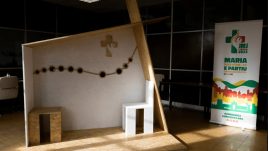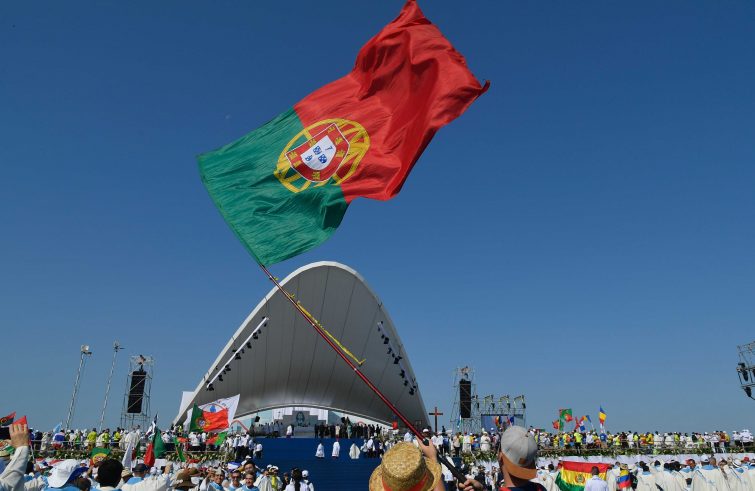
“If the WYD Lisbon were described in two words, these would be ‘generosity’ and ‘welcome’. The Portuguese capital is extending its open arms to the incoming young people. Generosity and welcome are two hallmarks of the Portuguese people.”
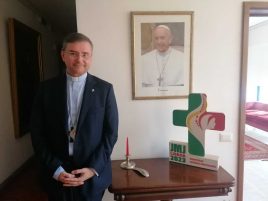 Speaking with SIR, Msgr. Américo Aguiar, auxiliary bishop of Lisbon and president of the WYD 2023 Foundation, describes the preparations for the World Youth Day to be held in Lisbon next August 1-6. The WYD, originally planned for 2022, was postponed by a year by Pope Francis due to the pandemic. Having defeated COVID, but with the Russian-Ukrainian war raging on European soil, the WYD returns to the Old Continent, after Krakow in 2016, and Panama in January 2019.
Speaking with SIR, Msgr. Américo Aguiar, auxiliary bishop of Lisbon and president of the WYD 2023 Foundation, describes the preparations for the World Youth Day to be held in Lisbon next August 1-6. The WYD, originally planned for 2022, was postponed by a year by Pope Francis due to the pandemic. Having defeated COVID, but with the Russian-Ukrainian war raging on European soil, the WYD returns to the Old Continent, after Krakow in 2016, and Panama in January 2019.
Your Excellency, what will the WYD in Lisbon be like?
It will be the WYD of encounter. The theme chosen by Pope Francis, “Mary got up and went in haste”, from the Gospel of Luke, denotes the action of going out to meet someone. Getting up is also the verb used in Scripture to indicate the Resurrection. Thus, the WYD in Lisbon aims to be an incentive for young people to get up and meet other people. This message is all the more meaningful considering that this is the first post-pandemic WYD. The preceding period was a time when we were forced to keep a physical distance from one another. This WYD can bring about a positive change for our young people. A pandemic, an economic crisis, the war in Europe between Russia and Ukraine: all of this occurred since the day when the Lisbon WYD was first announced in Panama in 2019. We can perceive the Pontiff’s great anticipation for this event. We are doing our utmost to ensure that the Day may be a special time to turn a new page with young people who are the protagonists of this change. We are committed to ensuring that Lisbon may usher in a new time for the new generations, a time when they will return to express their dreams and hopes for the future.
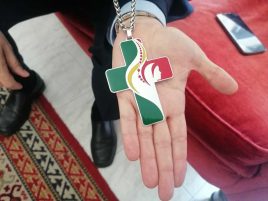 You mentioned Pope Francis’ expectations for this WYD just now. What are they?
You mentioned Pope Francis’ expectations for this WYD just now. What are they?
The WYD in Lisbon aims to meet the Pope’s dreams and desires for this event, notably that the World Youth Day may occasion young people’s encounter with Christ. Young people will be the main protagonists. We are preparing for an event that will bring together not only their aspirations but also their concerns, their problems. The economic crisis, the war, the pandemic, have caused widespread loneliness amongst the young. We want to tell them that they are not alone. We are confident that in Lisbon they will have the wonderful opportunity of the encounter with Jesus, with the Pope, and with their peers.
How many young people have registered for WYD so far?
A total of 568,201 young people had completed the first registration form by March 30th. On the same day, there were 43,211 Italian registered participants, the second largest group after the Spaniards. Based on the experience of previous WYDs, we expect twice as many, if not three times as many participants registered for the Saturday Vigil and the final Sunday Mass. We are planning to welcome at least one million young people from 180 world countries, including Russians and Ukrainians. There are over 200 registered bishops so far, but there will certainly be more, while we have to wait for the registration of priests because they will all be arriving with the young people. We also expect young people from other Christian denominations and other faiths, such as Muslims, to attend the WYD. The invitation is open to all, to know and be known.
Do you expect many participants from the African continent? Could Portugal’s geographic and historical closeness to some African countries be favourable to their participation?
We expect many young people especially from Angola, Mozambique, Guinea Bissau, Cape Verde and São Tomé and Príncipe, which are Portuguese-speaking countries. As was the case with previous international WYDs, the solidarity fund of the Dicastery for the Laity, Family and Life, whose ‘Youth Section’ organises the international WYD events, has been activated. This will enable the participation of many young people who have fewer opportunities to reach Lisbon.
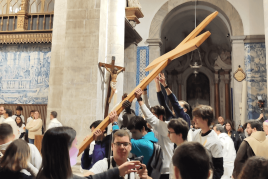 The technical-organisational preparations for the WYD are accompanied by the spiritual preparations that are represented, in particular, by the WYD symbols: the Pilgrim Cross and the icon of Our Lady that is being brought in pilgrimage to all Portuguese dioceses…
The technical-organisational preparations for the WYD are accompanied by the spiritual preparations that are represented, in particular, by the WYD symbols: the Pilgrim Cross and the icon of Our Lady that is being brought in pilgrimage to all Portuguese dioceses…
The Pilgrimage of the WYD symbols recently passed through the diocese of Aveiro. It will reach the diocese of Coimbra in April, then Fatima in May, Santarem in June and finally Lisbon. The pilgrimage started two years ago, on July 8, 2021, in Luanda, Angola. I am personally accompanying this pilgrimage and I think it is the most beautiful sign of the WYD, for I have seen the deep faith of so many young people. It is they who are the fruits of the WYD. However, I cannot fail to notice the weakness of the pastoral structures that are supposed to welcome them. I see them carry the Cross and the Icon of Mary everywhere, among their peers, in hospitals, prisons, barracks, schools, everywhere. They bring hope to those existential and geographic peripheries that are people rarely visit.
First and foremost, we signed a collaboration agreement last February with the General Directorate for Rehabilitation and Prison Services, for the building of 150 confessionals that will be used for the WYD. This project aims to involve inmates serving sentences in the prisons of Coimbra, Paços de Ferreira and Porto, to help with the preparations of the Day, and to promote their social reintegration once they are released. In prisons, I saw the transfigured faces of prisoners standing before the Cross and the Icon of Our Lady.
A choir of deaf people that will enliven the papal celebrations, a 5-language website, the Vocational Fair, the Youth Festival, the City of Joy, and other initiatives launched by the Local Organising Committee of Lisbon will complement another topical moment of the WYD, the Days in the Dioceses ( July 26-31), leading up to the papal agenda, which will celebrate the twinning of Portuguese dioceses with those of other countries. At what stage is the organisation?
It should be said that the dioceses of Lisbon, Setubal and Santarem will not be receiving guests because they will be hosting young people during the WYD – August 1 to 6. Hundreds of thousands of young people, approximately 200,000 to date, will be arriving in the other dioceses and that of the Military Ordinariate for the twinning. The purpose of the Days of the Dioceses is to integrate young people from world countries into Portuguese parish communities. During this time, participants will have the opportunity to learn more about the host region, the local Church and its specific characteristics, while they are hosted by families, in parish or public facilities, thus enjoying a new Church experience. We are currently working on a programme featuring five pillars: welcome, discovery, mission, cultures and outreach.
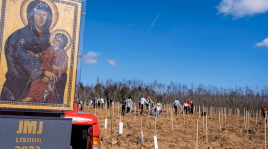 The care of Creation is among the issues dear to Pope Francis: will it be a sustainable WYD in the wake of Laudato si’?
The care of Creation is among the issues dear to Pope Francis: will it be a sustainable WYD in the wake of Laudato si’?
It will be a ‘green’ WYD: thousands of trees are being planted to make this event economically, environmentally and ecologically sustainable. A total of one thousand native trees dedicated to the WYD were planted in the diocese of Aveiro at the end of March. The initiative came about as a response to last year’s wildfires that severely impacted the area. It is also a response to the global challenge of planting new trees, launched by the WYD local organising committee in partnership with the Global Tree Initiative (GTI), to compensate for part of the environmental burden created during the papal event. To date, more than 7,300 trees dedicated to WYD Lisbon 2023 have already been planted in various parts of the world. I also wish to add that the site where the Vigil and Final Mass will take place, immediately after the closing of the WYD, will become a 50-hectare green park open to the public. This former industrial area was reclaimed for Expo 1998. This reclamation will now be completed for the WYD, and the area will once again be open to visitors. The park will be the legacy of the WYD for Lisbon. But there is one more aspect I would like to highlight…
Which is…?
WYD Lisbon will also be a first for digital natives, since most participants were born and grew up when the new information technologies became widespread. Also for this reason there will be no paper publications related to the WYD, but only digital ones. We will also facilitate waste management: we are currently studying ways to minimise the packaging of the young people’s food parcels.
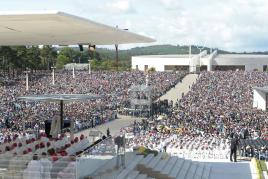 Lisbon calls Fatima: it will be a WYD that has a Marian flavour. In what way will the Marian shrine be included in the WYD programme?
Lisbon calls Fatima: it will be a WYD that has a Marian flavour. In what way will the Marian shrine be included in the WYD programme?
The Pope will certainly visit Fatima, but we still don’t know when. That will probably be an appropriate occasion for the Pontiff to meet not only the young people, but also many other faithful who will thus have the opportunity to show him their affection. Fatima is a key site for the WYD. Young people will flock there throughout the course of the event and even afterwards. Other events are also being planned. However, it would be premature to discuss it now (he smiles, Ed.’s note). The WYD in Lisbon will be provocative and missionary. Its theme is an invitation for us all to get up, like Mary who goes forth to meet Elizabeth. In doing so, she brings Jesus to meet her cousin Elizabeth and her son, John the Baptist, whom she carried in her womb. This ‘four-person’ meeting epitomises young people’s material needs and spiritual aspirations.

